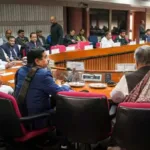Watch Rath Yatra 2024 Live ➡
The annual Rath Yatra, one of the most awaited festivals in Odisha, has begun in the coastal city of Puri. This grand chariot festival, dedicated to Lord Jagannath, his brother Balabhadra, and sister Subhadra, draws millions of devotees and tourists from across the globe. The Rath Yatra is not merely a religious event but a cultural phenomenon that showcases the rich heritage and spiritual fervor of Odisha.
Historical Significance
The origins of the Rath Yatra date back to ancient times, with its first recorded celebration occurring in the 12th century. The festival’s roots are intertwined with the history of the Jagannath Temple, which was constructed by King Anantavarman Chodaganga Deva of the Eastern Ganga dynasty. The temple, an architectural marvel, has been a significant pilgrimage site for centuries.
The Rath Yatra commemorates the annual journey of Lord Jagannath, an incarnation of Lord Vishnu, from his temple to the Gundicha Temple, located 3 kilometers away. The festival is a reenactment of this divine voyage, where the deities leave their sanctum sanctorum and come out to mingle with their devotees, breaking the barriers of caste, creed, and religion.
The Chariots
The construction of the massive chariots begins months in advance. Each deity has a distinct chariot:
- Nandighosa: The chariot of Lord Jagannath, adorned in yellow and red, stands 45 feet tall with 18 wheels.
- Taladhwaja: The chariot of Lord Balabhadra, decked in blue and red, is 44 feet high with 16 wheels.
- Devadalana: The chariot of Devi Subhadra, featuring a black and red motif, reaches a height of 43 feet with 14 wheels.
More Read
The chariots are meticulously crafted from specific types of wood, sourced from particular trees that are considered sacred. Carpenters and artisans, following traditional techniques passed down through generations, ensure that each chariot is an epitome of craftsmanship and devotion.
The Journey
The Rath Yatra begins with the ceremonial procession known as the “Pahandi,” where the deities are brought out of the temple amidst chants, music, and dancing. Thousands of devotees jostle for a glimpse and the opportunity to pull the ropes of the chariots, believing it will wash away their sins and bring them blessings.
As the chariots roll towards the Gundicha Temple, the atmosphere is charged with spiritual energy. Devotees from all walks of life participate, reflecting the inclusive nature of the festival. The deities stay at the Gundicha Temple for seven days before returning to the Jagannath Temple in a similar procession known as the “Bahuda Yatra.“
Cultural and Social Impact
The Rath Yatra is not only a religious event but also a social and cultural extravaganza. It brings together a diverse group of people, fostering a sense of unity and communal harmony. The festival also boosts the local economy, with countless vendors, artisans, and service providers benefiting from the influx of pilgrims and tourists.
The festival has also inspired numerous art forms, including music, dance, and painting. Odissi dance performances, folk songs, and vibrant murals depicting scenes from the Rath Yatra are integral parts of Odisha’s cultural landscape.
Global Reach
Over the years, the Rath Yatra has transcended geographical boundaries. Similar festivals are celebrated by Odia communities and Hindu temples worldwide, spreading the message of Lord Jagannath’s love and compassion. Major cities in the United States, Canada, the United Kingdom, and Australia, among others, host Rath Yatras, drawing participants from various cultural backgrounds.
Detailed Schedule and Significance
The Rath Yatra festival in Puri, Odisha, is a meticulously planned event that spans several days, each with its own religious and cultural significance. Here’s a breakdown of the key days and their importance from the commencement of the festival until the deities return to the Jagannath Temple.
Snana Purnima (Bathing Festival)
- Date: Full moon day of the Hindu month of Jyeshtha (June)
- Significance: This is the first major event that marks the beginning of the Rath Yatra celebrations. The idols of Lord Jagannath, Balabhadra, and Subhadra are brought out for a ceremonial bath with 108 pots of ritually purified water. This is believed to purify and refresh the deities.
Anavasara (Anasara) Period
- Date: The fortnight following Snana Purnima
- Significance: After the grand bathing ceremony, the deities are believed to fall ill and are not visible to the public for a period known as Anavasara. During this time, special healing rituals are performed, and the deities are kept in a special sick room (Anasara Ghara).
Netrotsava (Nava Yauvana Darshan)
- Date: The day before Rath Yatra
- Significance: After recovering from their illness, the deities are given a fresh coat of paint and are presented to the public in their rejuvenated forms. This is known as the “festival of the eyes.”
Rath Yatra (Gundicha Yatra)
- Date: Second day of the bright fortnight of the Hindu month of Ashadha (June-July)
- Significance: This is the main day of the festival when the deities are placed on their respective chariots and pulled to the Gundicha Temple, which is believed to be the birthplace of Lord Jagannath. The journey symbolizes Lord Jagannath’s visit to his birthplace.
Gundicha Temple Stay
- Date: The deities stay at the Gundicha Temple for seven days
- Significance: The deities reside at the Gundicha Temple, where they are worshipped and various rituals are performed. This period is marked by celebrations, feasts, and devotional activities.
Hera Panchami
- Date: The fifth day of the bright fortnight of Ashadha
- Significance: On this day, Goddess Lakshmi, the consort of Lord Jagannath, visits the Gundicha Temple to see her husband. The event is symbolic of her displeasure at being left behind at the main temple and her subsequent reunion with Lord Jagannath.
Bahuda Yatra (Return Journey)
- Date: Ninth day of the bright fortnight of Ashadha
- Significance: The return journey of the deities to the Jagannath Temple is called Bahuda Yatra. The deities are placed back on their chariots and pulled back to the main temple. This event is as grand as the initial journey, with devotees thronging the streets to get a glimpse of the deities.
Suna Besha (Golden Attire)
- Date: The day after Bahuda Yatra
- Significance: The deities are adorned with gold ornaments and exhibited to the public in a grand display known as Suna Besha or Rajadhiraja Besha. This is one of the most visually stunning events of the festival, attracting a large number of devotees.
Adhara Pana
- Date: The day after Suna Besha
- Significance: On this day, a special drink called Adhara Pana is offered to the deities. Large pots filled with this sweet drink are placed on the chariots, and the deities are believed to consume it through their lips drawn on the pots.
Niladri Bijay
- Date: The final day of the festival
- Significance: This marks the end of the Rath Yatra festival. The deities are ceremoniously brought back into the sanctum sanctorum of the Jagannath Temple. This day is also known for the symbolic ritual where Goddess Lakshmi bars the entry of Lord Jagannath into the temple, allowing him entry only after he offers her sweet treats and appeases her.
The Odisha Rath Yatra is a festival rich in rituals and significance, reflecting the deep devotion of the devotees and the cultural heritage of Odisha. Each day of the festival holds a special place in the hearts of the devotees, culminating in a grand celebration of faith, unity, and tradition.
The Odisha Rath Yatra is a testament to the enduring power of faith and tradition. It is a celebration of devotion, community, and cultural heritage, reflecting the timeless values that bind humanity together. As the chariots of Lord Jagannath, Balabhadra, and Subhadra make their way through the streets of Puri, they carry with them the hopes, prayers, and aspirations of millions, reaffirming the eternal bond between the divine and the devotees.











